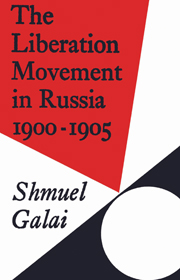Book contents
- Frontmatter
- Contents
- Dedication
- Acknowledgments
- Note on dates, etc.
- List of abbreviations
- Introduction
- Part One ORIGINS
- 1 The origins of zemstvo radicalism
- 2 The beginnings of the zemstvo oppositional movement
- 3 The birth of the democratic intelligentsia
- 4 The parting of the ways
- Part Two THE FORMATION OF THE LIBERATION MOVEMENT
- Part Three WAR AND REVOLUTION
- Appendix A The origins of Beseda
- Appendix B A bibliographical note on the writings of Kuskova and Prokopovich in the years 1898–9
- Appendix C Note on sources on the formation of the Liberation Movement
- Bibliography
- Index
2 - The beginnings of the zemstvo oppositional movement
Published online by Cambridge University Press: 22 September 2009
- Frontmatter
- Contents
- Dedication
- Acknowledgments
- Note on dates, etc.
- List of abbreviations
- Introduction
- Part One ORIGINS
- 1 The origins of zemstvo radicalism
- 2 The beginnings of the zemstvo oppositional movement
- 3 The birth of the democratic intelligentsia
- 4 The parting of the ways
- Part Two THE FORMATION OF THE LIBERATION MOVEMENT
- Part Three WAR AND REVOLUTION
- Appendix A The origins of Beseda
- Appendix B A bibliographical note on the writings of Kuskova and Prokopovich in the years 1898–9
- Appendix C Note on sources on the formation of the Liberation Movement
- Bibliography
- Index
Summary
The last decade of the nineteenth century was characterized by the unprecedentedly high rate of industrial expansion in Russia (8 per cent per annum) encouraged by S. Yu. Witte, and by the stabilization of the monetary system on the gold standard. But it also witnessed the severe aggravation of the endemic agricultural crisis, and these developments were not unconnected.
As in other backward countries, the agricultural crisis in Russia manifested itself in a very low output growth rate which barely kept pace with the increase in population, and in its complete subjection to the vagaries of nature. According to the calculations of a modern economic historian, the average annual rate of growth of agricultural output in the Russian Empire was less than two per cent during the period 1861–1913. In years in which natural disasters occurred, and these were particularly frequent towards the end of the century, output either stood still or declined. In the same period the total population of the Empire more than doubled (from 74 million in 1858 to 129 million in 1897 and 175 million in 1913), and the rural population increased proportionately, continuing to constitute almost 90 per cent of the total. At the end of the nineteenth century there were some 97 million peasants in the rural population as against less than one and a half million nobles (according to the 1897 census), and even in the best of years they could barely maintain their standard of living at the very low pre-emancipation level.
- Type
- Chapter
- Information
- The Liberation Movement in Russia 1900–1905 , pp. 34 - 57Publisher: Cambridge University PressPrint publication year: 1973



